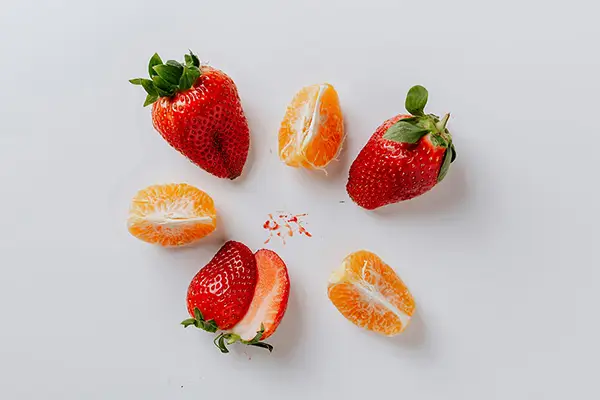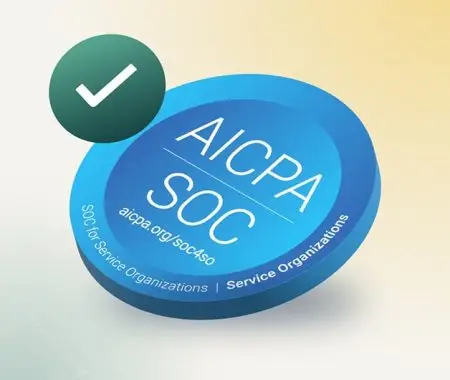How to Optimize Recipe Nutrition Profiles
Whether you’re a food blogger, an executive chef, or a food and beverage company, optimizing your recipes’ nutrition profiles is a necessity. Nutrition plays vital role in today’s society, with people becoming more health-conscious and regulations becoming more stringent to protect consumers. Providing accurate and detailed nutritional information is both crucial for building trust with your customers and ensuring they make informed decisions regarding their health and diets.
This is where food formulation software comes in, as it assists you with calculating precise nutrition data so you can fine-tune your recipes for better health outcomes. They streamline the process of creating nutrition labels and ensure you’re not just guessing but providing reliable nutrition information that meets both consumer expectations and regulatory standards.
Importance of Accurate Nutrition Information
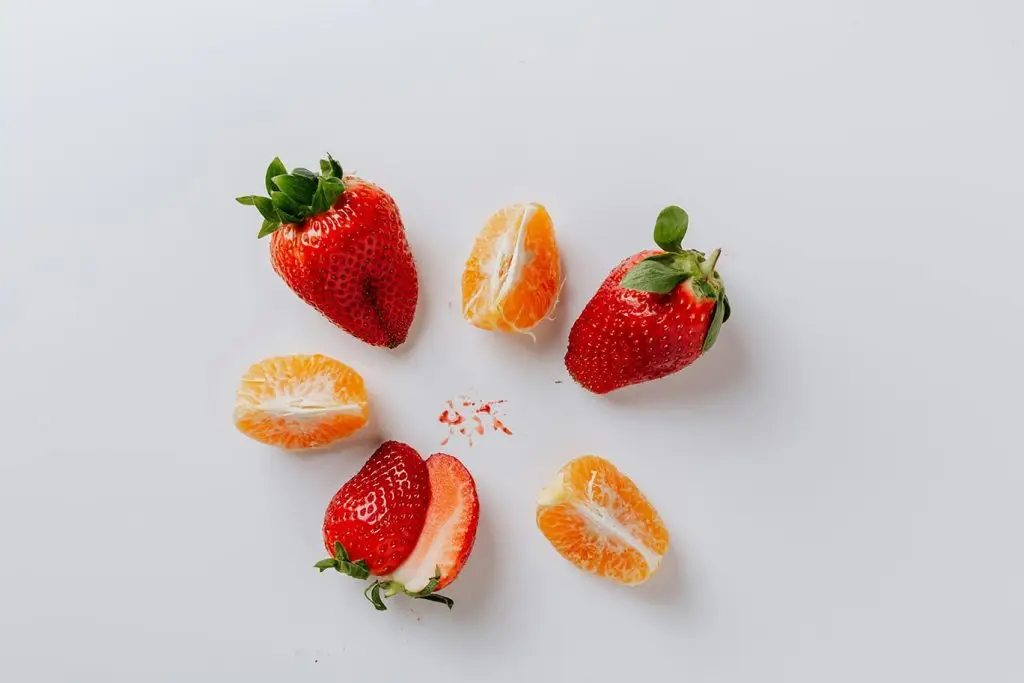
Accurate nutritional information is crucial for consumer trust and regulatory compliance. Inaccurate or misleading data can lead to consumer dissatisfaction, potential health risks, and even legal consequences, including fines or product recalls. Consumers today are more informed and vigilant about what they eat, expecting transparency about everything from calories and macronutrients to allergens and additives.
Platforms like Food Label Maker ensure recipes are backed by accurate nutritional data, building trust and complying with regulations set by international bodies like the FDA and Mexico’s NOM-051. Food Label Maker also offers features that go beyond just basic nutrition calculation. Features like automated allergen detection are particularly valuable for those catering to individuals with dietary restrictions. Additionally, editable ingredient and allergen lists allow for flexibility, ensuring labels are always up-to-date and accurate.
Optimizing Recipe Nutrition Profiles with Software
When it comes to refining the nutrition profiles of your recipes, the right software can make all the difference. Food Label Maker’s suite of powerful tools is specifically designed to analyze and enhance the nutritional content of your dishes, ensuring they meet the highest standards of health and compliance.
Nutrition Breakdown Reports
The software generates detailed nutrition breakdown reports after you input your ingredients and amounts. These reports break down the nutritional content per serving size or per 100g, presented in values or percentages. This level of detail allows you to see exactly how each ingredient contributes to the overall nutrition value, enabling informed decisions on where adjustments can be made. It’s particularly valuable when aiming to create balanced meals or meet specific dietary guidelines.
Informative Recipe Cards
Food Label Maker creates detailed recipe cards that showcase all essential aspects of your dish. These cards include the recipe name, a complete list of ingredients, nutrition facts, allergen information, and step-by-step cooking instructions. You can also include a visual representation of the dish, making the recipe card not only informative but also visually appealing. Whether you’re standardizing kitchen processes or sharing detailed recipes with customers, these customizable recipe cards provide a comprehensive picture of your recipe.
Customized Ingredients and a Comprehensive Database
The software also boasts an extensive database of individual ingredients, which you can customize as you see fit. You can also add custom ingredients if they are not in our existing database, so that even the most unique recipes are precisely analyzed. This flexibility is crucial for chefs and food companies that frequently experiment with new ingredients or cater to niche markets.
By leveraging these helpful features, you can more easily identify areas where you can improve the nutritional value of your recipes. Whether you are reducing calories, balancing macronutrients, or avoiding allergens, Food Label Maker provides the insights and suggestions you need to optimize your recipes for better health outcomes.
Real-World Examples
Hill Country Chocolate
Hill Country Chocolate, a Texas-based artisanal chocolate shop, found Food Label Maker to be a game-changer in simplifying their recipe optimization and labeling process. Initially overwhelmed by the complexities of labeling their many products, they struggled with an expensive and hard-to-use service before using our label maker. Founder Dan McCoy stated, “It felt like Food Label Maker offers a concierge approach to labeling, which made us instantly sign up.” The software’s features, like automated allergen detection and customizable ingredient lists, made it simple to ensure their products met regulatory standards across different markets.
Meez Meals
Meez Meals, a meal kit delivery service dedicated to fresh and customizable meals, has seen impressive results using Food Label Maker. According to Judy Glass, VP of Operations, the software’s simplicity and intuitive design were crucial in solving their challenge of generating accurate and detailed nutrition facts. Before adopting Food Label Maker, the company struggled with time-consuming and manual calculations that yielded inaccurate results. Now, the tool allows Meez Meals to quickly duplicate recipes for various dietary needs, efficiently manage and scale recipes, and easily add custom ingredients. They have seen a significant improvement in their ability to provide precise nutritional information, enhancing customer trust and satisfaction.
See How FoodLabelMaker Can Help You
Practical Tips for Using Recipe Nutrition Calculators
Using a recipe nutrition calculator like Food Label Maker is straightforward, but there are a few best practices to keep in mind to ensure you get the most accurate and useful results. Here’s a step-by-step guide to help you navigate the process:
Step 1: Input Your Recipe
Begin by entering your recipe into the software. This includes listing all ingredients, quantities, and measurements. Make sure to be as detailed as possible—include every ingredient, even those used in small amounts, as they can still impact the overall nutrition profile.
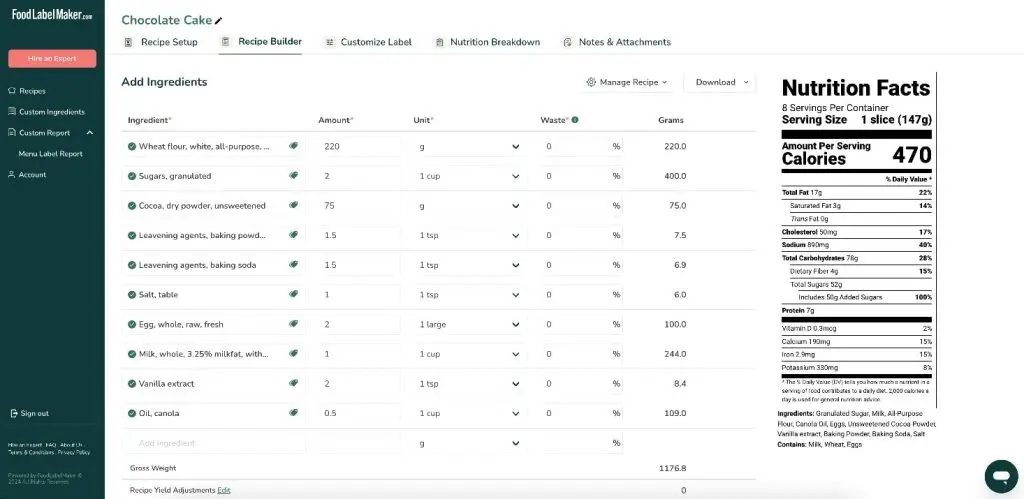
Step 2: Customize Ingredients
If your recipe includes any unique or custom ingredients not found in the standard database, you can add them manually. Simply name the ingredient and input the nutritional information for the custom ingredient, and the software will incorporate it into your recipe analysis.


Step 3: Generate Nutrition Breakdown
Once all ingredients are entered, the software generates a nutrition breakdown report. This report will provide detailed information on the calories, macronutrients (carbohydrates, fats, and proteins), and micronutrients (vitamins and minerals) in your recipe.
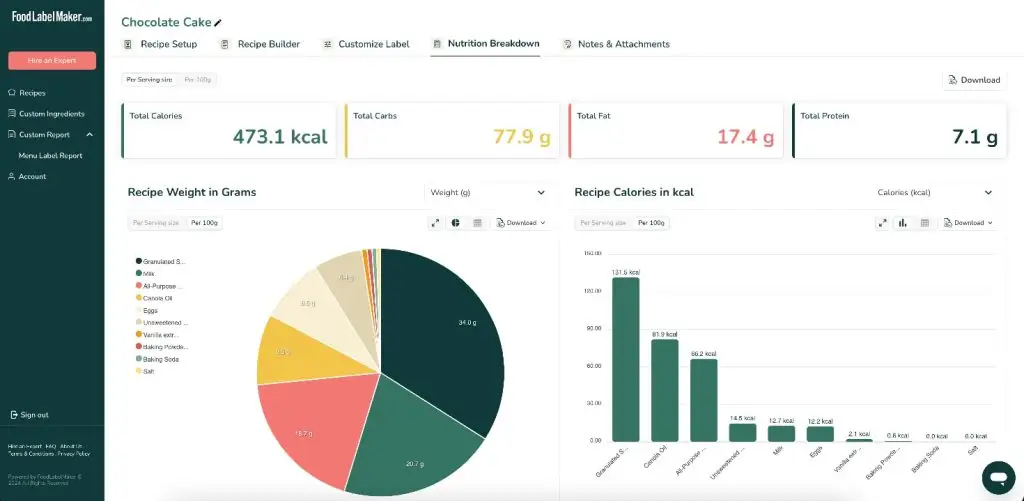

Step 4: Update and Finalize
After making any adjustments, update your recipe in the software and generate a new nutrition breakdown. This will give you an updated view of how the changes have impacted the nutrition profile. Continue refining until you’re satisfied with the results.
Tips for Accurate Results:
- Measure Precisely: Ensure all ingredient measurements are accurate. Use a kitchen scale for best results, especially with ingredients like flour and sugar.
- Include Cooking Methods: Some cooking methods can alter the nutritional content of ingredients (e.g., frying increases fat content). Be sure to specify how each ingredient is prepared.
- Review Ingredient Data: Double-check the nutritional information for any custom ingredients you add to the database to avoid inaccuracies.
Ingredient Substitutions and Modifications for Healthier Recipes

Creating healthier recipes often involves making strategic ingredient substitutions that enhance nutritional value without compromising taste. Here are some common substitutions and how Food Label Maker can assist in assessing their impact:
Natural Sweeteners vs. Sugar
Refined sugar is a common target for substitution in healthier recipes. Natural sweeteners like honey, maple syrup, or stevia can reduce the glycemic load and add additional nutrients. For instance, swapping sugar with honey can introduce antioxidants and provide a slower energy release. Food Label Maker’s nutrition breakdown feature allows you to test these substitutions and immediately see how they affect the overall sugar content and calorie count of your recipe.
Whole Grains vs. Refined Grains
Another common substitution is replacing refined grains with whole grains. For example, you might substitute white flour with whole wheat flour or use quinoa instead of white rice. Whole grains are richer in fiber, vitamins, and minerals, which can significantly improve the nutritional profile of your dish. The software’s comprehensive database makes it easy to compare these ingredients and see the benefits in real-time.
Healthy Fats vs. Saturated Fats
Replacing saturated fats with healthier options is another way to optimize your recipes and make them healthier for your consumers. Consider using olive oil or avocado instead of butter, or swapping full-fat dairy products with lower-fat versions or alternative milks. The software can suggest these modifications and show how they affect the fat content and overall caloric value.
Plant-Based Ingredients
For those looking to create vegan or vegetarian recipes, substituting animal products with plant-based alternatives can be a key focus. For example, using tofu instead of chicken or almond milk instead of dairy can lower cholesterol and saturated fat intake. Food Label Maker allows you to experiment with these substitutions and see how they impact protein levels, calcium content, and other essential nutrients.
By making thoughtful ingredient substitutions and using Food Label Maker to analyze the results, you can create healthier, more nutritious recipes that still deliver flavor and satisfaction.
Conclusion
In today’s society where consumers are watching what they eat, optimizing your recipe’s nutrition profile is imperative to thrive in the food and beverage industry.
Having accurate nutritional information on your food products builds trust, ensures compliance, and helps consumers make smarter decisions when it comes to their diets.
Tools like Food Label Maker are invaluable for this process, making it seamless, quick and easy to calculate correct nutritional values and create eye-catching recipe cards. It is also helpful to measure your ingredients carefully, consider how you prepare your recipes, and substitute or get creative with healthier ingredients. By mixing smart software with culinary creativity, businesses can create recipes and dishes that are tasteful, compliant and satisfy consumer demands in a competitive industry.

